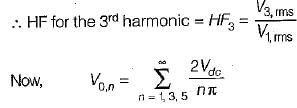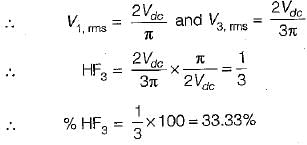Electrical Engineering (EE) Exam > Electrical Engineering (EE) Questions > A single-phase half-bridge inverter has a res...
Start Learning for Free
A single-phase half-bridge inverter has a resistive load of R = 3 Ω and the dc input voltage Vdc = 24 volts. The harmonic factor of the lowest order harmonic would be equal to
- a)33.33%
- b)25.0%
- c)66.67%
- d)50.0%
Correct answer is option 'A'. Can you explain this answer?
| FREE This question is part of | Download PDF Attempt this Test |
Verified Answer
A single-phase half-bridge inverter has a resistive load of R = 3 &Ome...
The lowest harmonic is third harmonic




Most Upvoted Answer
A single-phase half-bridge inverter has a resistive load of R = 3 &Ome...
In a single-phase half-bridge inverter with a resistive load of R = 3, the inverter will convert DC power to AC power by switching the polarity of the output voltage. The inverter consists of two switches, typically MOSFETs, connected in series with the load.
During the positive half-cycle of the AC waveform, the upper switch is turned on and the lower switch is turned off. This allows current to flow from the positive DC bus through the upper switch, through the load resistor, and back to the negative DC bus.
During the negative half-cycle of the AC waveform, the upper switch is turned off and the lower switch is turned on. This allows current to flow from the negative DC bus through the lower switch, through the load resistor in the opposite direction, and back to the positive DC bus.
By switching the polarity of the output voltage, the inverter creates an AC waveform across the load resistor with a frequency determined by the switching frequency of the switches. The magnitude of the output voltage will depend on the input DC voltage and the resistance of the load.
In the case of a resistive load of R = 3, the output current will be V/R, where V is the magnitude of the output voltage. The power dissipated in the load will be I^2 * R, where I is the output current.
During the positive half-cycle of the AC waveform, the upper switch is turned on and the lower switch is turned off. This allows current to flow from the positive DC bus through the upper switch, through the load resistor, and back to the negative DC bus.
During the negative half-cycle of the AC waveform, the upper switch is turned off and the lower switch is turned on. This allows current to flow from the negative DC bus through the lower switch, through the load resistor in the opposite direction, and back to the positive DC bus.
By switching the polarity of the output voltage, the inverter creates an AC waveform across the load resistor with a frequency determined by the switching frequency of the switches. The magnitude of the output voltage will depend on the input DC voltage and the resistance of the load.
In the case of a resistive load of R = 3, the output current will be V/R, where V is the magnitude of the output voltage. The power dissipated in the load will be I^2 * R, where I is the output current.
Attention Electrical Engineering (EE) Students!
To make sure you are not studying endlessly, EduRev has designed Electrical Engineering (EE) study material, with Structured Courses, Videos, & Test Series. Plus get personalized analysis, doubt solving and improvement plans to achieve a great score in Electrical Engineering (EE).

|
Explore Courses for Electrical Engineering (EE) exam
|

|
Similar Electrical Engineering (EE) Doubts
A single-phase half-bridge inverter has a resistive load of R = 3 Ω and the dc input voltage Vdc = 24 volts. The harmonic factor of the lowest order harmonic would be equal toa)33.33%b)25.0%c)66.67%d)50.0%Correct answer is option 'A'. Can you explain this answer?
Question Description
A single-phase half-bridge inverter has a resistive load of R = 3 Ω and the dc input voltage Vdc = 24 volts. The harmonic factor of the lowest order harmonic would be equal toa)33.33%b)25.0%c)66.67%d)50.0%Correct answer is option 'A'. Can you explain this answer? for Electrical Engineering (EE) 2024 is part of Electrical Engineering (EE) preparation. The Question and answers have been prepared according to the Electrical Engineering (EE) exam syllabus. Information about A single-phase half-bridge inverter has a resistive load of R = 3 Ω and the dc input voltage Vdc = 24 volts. The harmonic factor of the lowest order harmonic would be equal toa)33.33%b)25.0%c)66.67%d)50.0%Correct answer is option 'A'. Can you explain this answer? covers all topics & solutions for Electrical Engineering (EE) 2024 Exam. Find important definitions, questions, meanings, examples, exercises and tests below for A single-phase half-bridge inverter has a resistive load of R = 3 Ω and the dc input voltage Vdc = 24 volts. The harmonic factor of the lowest order harmonic would be equal toa)33.33%b)25.0%c)66.67%d)50.0%Correct answer is option 'A'. Can you explain this answer?.
A single-phase half-bridge inverter has a resistive load of R = 3 Ω and the dc input voltage Vdc = 24 volts. The harmonic factor of the lowest order harmonic would be equal toa)33.33%b)25.0%c)66.67%d)50.0%Correct answer is option 'A'. Can you explain this answer? for Electrical Engineering (EE) 2024 is part of Electrical Engineering (EE) preparation. The Question and answers have been prepared according to the Electrical Engineering (EE) exam syllabus. Information about A single-phase half-bridge inverter has a resistive load of R = 3 Ω and the dc input voltage Vdc = 24 volts. The harmonic factor of the lowest order harmonic would be equal toa)33.33%b)25.0%c)66.67%d)50.0%Correct answer is option 'A'. Can you explain this answer? covers all topics & solutions for Electrical Engineering (EE) 2024 Exam. Find important definitions, questions, meanings, examples, exercises and tests below for A single-phase half-bridge inverter has a resistive load of R = 3 Ω and the dc input voltage Vdc = 24 volts. The harmonic factor of the lowest order harmonic would be equal toa)33.33%b)25.0%c)66.67%d)50.0%Correct answer is option 'A'. Can you explain this answer?.
Solutions for A single-phase half-bridge inverter has a resistive load of R = 3 Ω and the dc input voltage Vdc = 24 volts. The harmonic factor of the lowest order harmonic would be equal toa)33.33%b)25.0%c)66.67%d)50.0%Correct answer is option 'A'. Can you explain this answer? in English & in Hindi are available as part of our courses for Electrical Engineering (EE).
Download more important topics, notes, lectures and mock test series for Electrical Engineering (EE) Exam by signing up for free.
Here you can find the meaning of A single-phase half-bridge inverter has a resistive load of R = 3 Ω and the dc input voltage Vdc = 24 volts. The harmonic factor of the lowest order harmonic would be equal toa)33.33%b)25.0%c)66.67%d)50.0%Correct answer is option 'A'. Can you explain this answer? defined & explained in the simplest way possible. Besides giving the explanation of
A single-phase half-bridge inverter has a resistive load of R = 3 Ω and the dc input voltage Vdc = 24 volts. The harmonic factor of the lowest order harmonic would be equal toa)33.33%b)25.0%c)66.67%d)50.0%Correct answer is option 'A'. Can you explain this answer?, a detailed solution for A single-phase half-bridge inverter has a resistive load of R = 3 Ω and the dc input voltage Vdc = 24 volts. The harmonic factor of the lowest order harmonic would be equal toa)33.33%b)25.0%c)66.67%d)50.0%Correct answer is option 'A'. Can you explain this answer? has been provided alongside types of A single-phase half-bridge inverter has a resistive load of R = 3 Ω and the dc input voltage Vdc = 24 volts. The harmonic factor of the lowest order harmonic would be equal toa)33.33%b)25.0%c)66.67%d)50.0%Correct answer is option 'A'. Can you explain this answer? theory, EduRev gives you an
ample number of questions to practice A single-phase half-bridge inverter has a resistive load of R = 3 Ω and the dc input voltage Vdc = 24 volts. The harmonic factor of the lowest order harmonic would be equal toa)33.33%b)25.0%c)66.67%d)50.0%Correct answer is option 'A'. Can you explain this answer? tests, examples and also practice Electrical Engineering (EE) tests.

|
Explore Courses for Electrical Engineering (EE) exam
|

|
Suggested Free Tests
Signup for Free!
Signup to see your scores go up within 7 days! Learn & Practice with 1000+ FREE Notes, Videos & Tests.
























